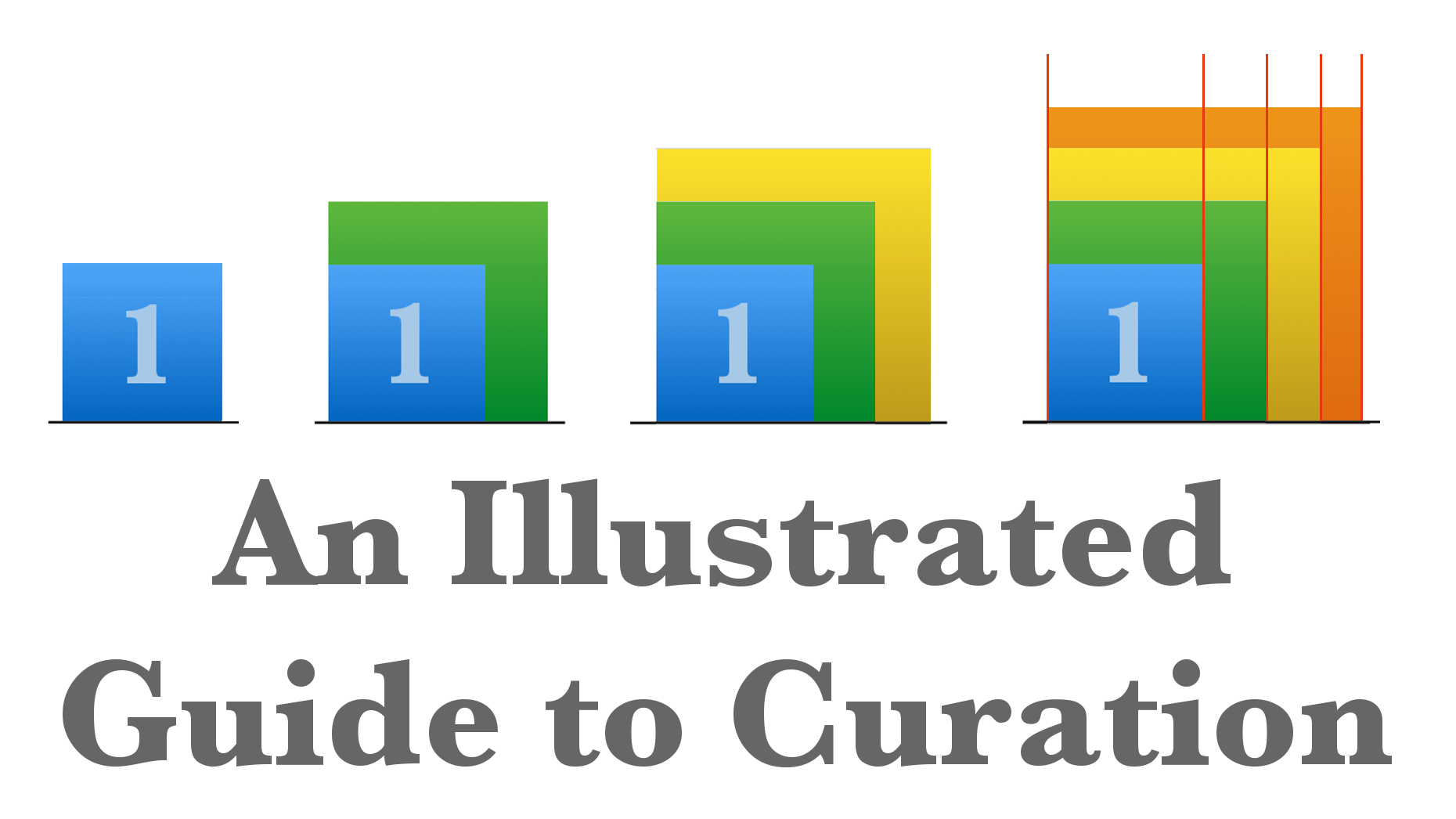
Curation rewards are a simple idea. But beneath the surface lie a multitude of complexities. In this series of posts we use illustrations and examples from past posts in an attempt to lay those complexities bare.
This is part 2 in a series of 3. Find part 1 here.
In part 1 we covered the basics of curation. We introduced a novel “squares visualisation” to illustrate the share of rewards received by each curator and used it to illustrate how a proportion of curation rewards are paid forwards to all previous curators on a post. We also looked at the proportion of curation rewards passed to post authors from upvotes in the first thirty minutes and how this effect continues even after this initial period is complete.
In part 2 we extend our analysis to build a model of of curation rewards over the full lifetime of a post. We use this model to explain why most upvoters receive close to the minimum level of curation rewards. We also examine how feasible it is for early curation rewards to exceed the value of the upvote which generated them. Finally we draw up some rules of thumb to help in estimating the curation rewards you will receive on a post. As in part 1 we back up all our analysis with real examples from past posts.
A Basic Model of Curation Rewards
We start by building a simple model of curation rewards for a single post. This model serves only to illustrate certain concepts that can be applied in understanding curation rewards. In practice the curation rewards arising from posts will follow individual patterns which may vary widely from the example below and indeed from each other. Later we will apply the concepts from our model to analyse the curation rewards from an actual past post.
The model assumes an upvote of $1.00 is received every five minutes, starting at t=0 (which could be considered as the author’s own upvote) and continuing for eight-and-a-half hours after which no more upvotes are received. At the end of this period the final post payout is $100.00.
The total curation rewards including those passed to the author are $100.00 x 25% = $25.00. The total curation rewards excluding those passed to the author are $20.49 or 20.5% of post payout. The difference arises from the six upvotes made within the first thirty minutes.
The following graphic charts the “curation reward in SBD / upvote value in SBD” ratio for each curator. As each upvote is equal and set at $1.00, the same pattern would be obtained if we produced a chart of the curation rewards in SBD (just by replacing the percentages on the y-axis with SBD cents).
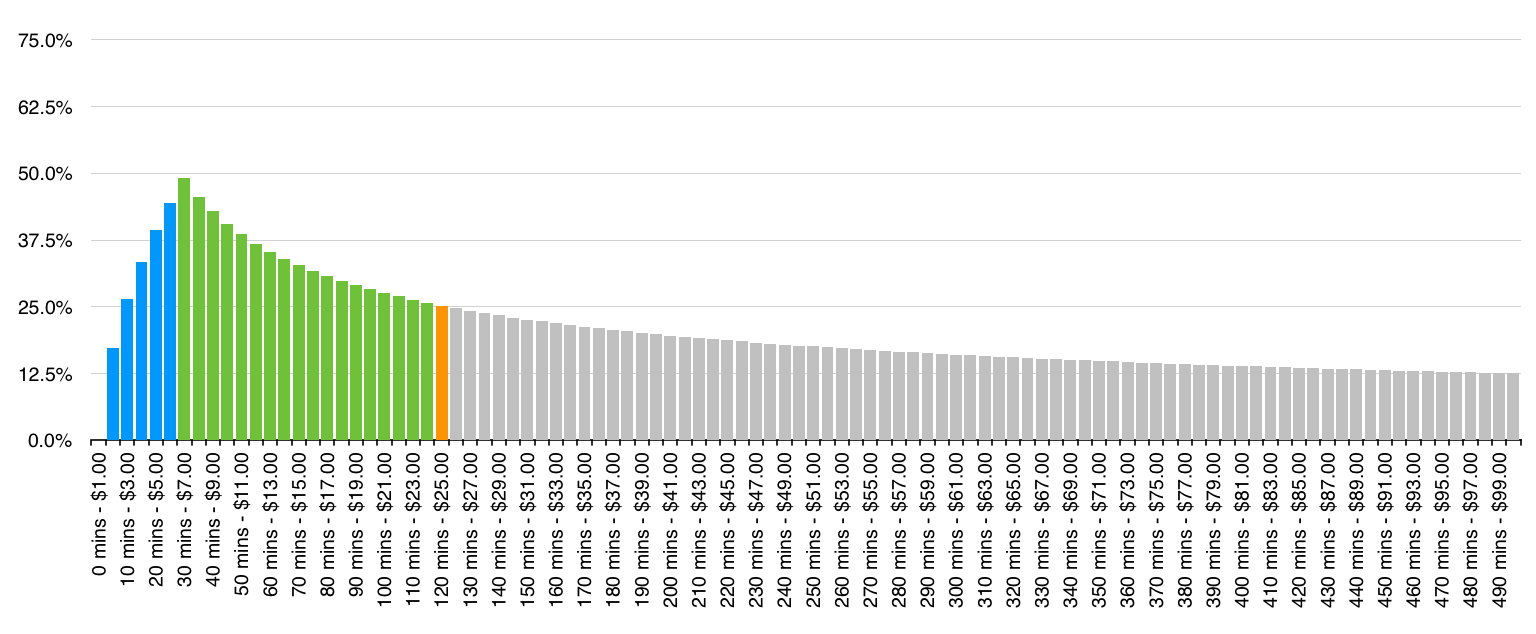
The blue columns represent upvotes made within the first 30 minutes. The orange column is the 25th upvote, with 25% of the post payout built up before this point (shown in green and blue) and 75% added afterwards (shown in grey). We refer back to this chart in the sections that follow.
A Useful Yardstick for Curation Rewards (the orange column in our model)
As we have previously noted, the current split of rewards is 75% of the post payout for authors and 25% for curators. In the simplest scenario, the curation reward for a post with a single upvote made after the thirty minute mark is 25% of the post payout, or equivalently 25% of the curator’s own upvote (which constitutes the entire post payout). This curation reward / upvote ratio of 25% is the level which a simple bot could obtain by upvoting random posts which have no previous upvotes. It is a useful yardstick level against which to measure rewards from other curation approaches. In the above chart, the 25th curator reward ratio has been highlighted as it receives this yardstick level of curation rewards.
Why Most Upvoters Receive Close to the Minimum Level of Curation Rewards (the grey columns in our model)
The theoretical minimum level of curation rewards is 12.5% of upvote. Our model can be seen to trend down to this level as the end of post upvoting approaches.
Three out of four curators in our model (those in grey) receive a reward between the 25% yardstick (in orange) and this 12.5% minimum. More than half of curators in our model are closer to the 12.5% minimum than the 25% yardstick. This result is not specific to our model but holds (by amount of upvote rather than by number of curators) for all examples and for all real posts. We can use our “squares visualisation” to illustrate this rule.
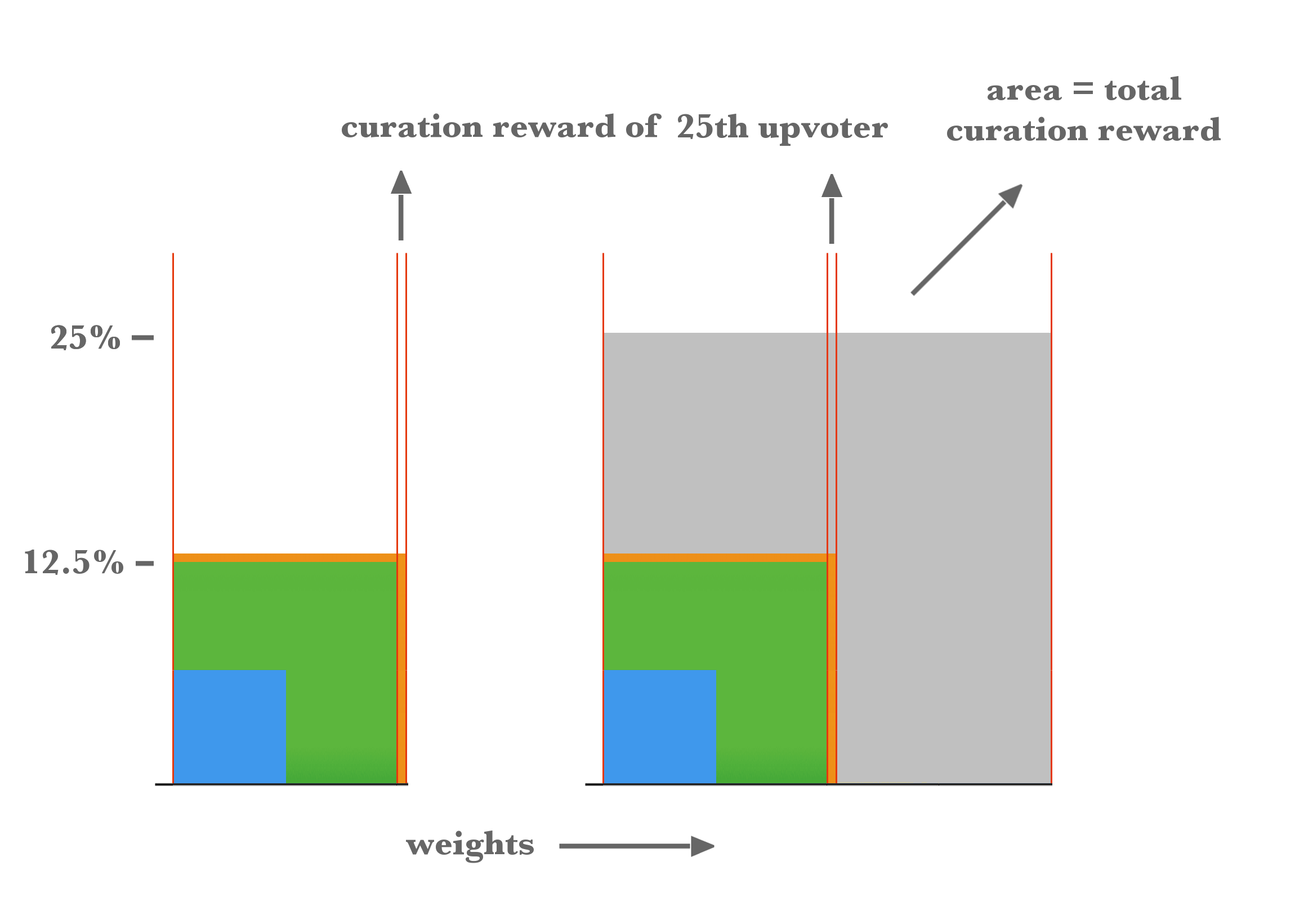
The area covered by the coloured square (including grey) represents the total curation rewards on the post. The colours are those from our model, with the orange angle-shaped area representing the curation rewards added by the 25th curator ($0.25).
The left hand illustration shows the position immediately after the 25th upvote. The overall post payout is $25.00. The 25th curator’s $1.00 upvote has added $0.25 to the total curation rewards making $6.25 in total (including the author’s share). Almost half of the $0.25 added is paid forward into the curation rewards of previous upvoters (the horizontal orange area) leaving the 25th curator with a curation reward of (just over) $0.125 at this point (the vertical orange area). This results in the minimum curation reward ratio of 12.5% of upvote.
The right hand illustration shows the position at completion of upvoting on the post. After the 100th upvote the overall post payout is $100.00, an increase of 4x since the the 25th upvote. We can see from the illustration that when the area of the square (the curation rewards) increases by four times, the curation rewards for the 25th upvoter doubles (the “height” of the orange vertical area together with the grey vertical column above it). The curation reward of the 25th upvoter had increased from $0.125 to $0.25; the 25% yardstick level for a $1.00 upvote. The amount of curation rewards paid forwards initially has in turn been recouped from later curators.
Each curator after the 25th also initially pays forward curation rewards and starts with a 12.5% curation reward / upvote ratio. However, since they are voting after the 25th percentile (by volume of upvotes) they will not obtain the required increase in post payout of 4x to double up and will thus receive less than the 25% yardstick. As a general rule, we can conclude that the last three-quarters of upvotes (by volume) do not reach the yardstick curation level.
Exceeding 100% of Upvote in Curation Rewards
Before turning our attention to the early curators in our model, let’s first consider the case of a curation hound who searches out high quality new posts with the aim of promoting them to the community. Assuming that (a) they are the first upvoter and (b) they vote after the thirty minute period has passed, they are neither paying forward curation rewards to previous upvoters nor returning rewards to the author. In this situation their initial curation reward / upvote ratio will be 25%. How much needs to be added to the post payout in order for their curation reward to double to 50%? How much needs to be added for the reward to triple to 75% or quadruple to reach the full 100% of their upvote?
We have already seen that increasing the post payout to 4x the size of their upvote will result in a doubling of their curation rewards. We can use our “squares visualisation” to illustrate the other results.
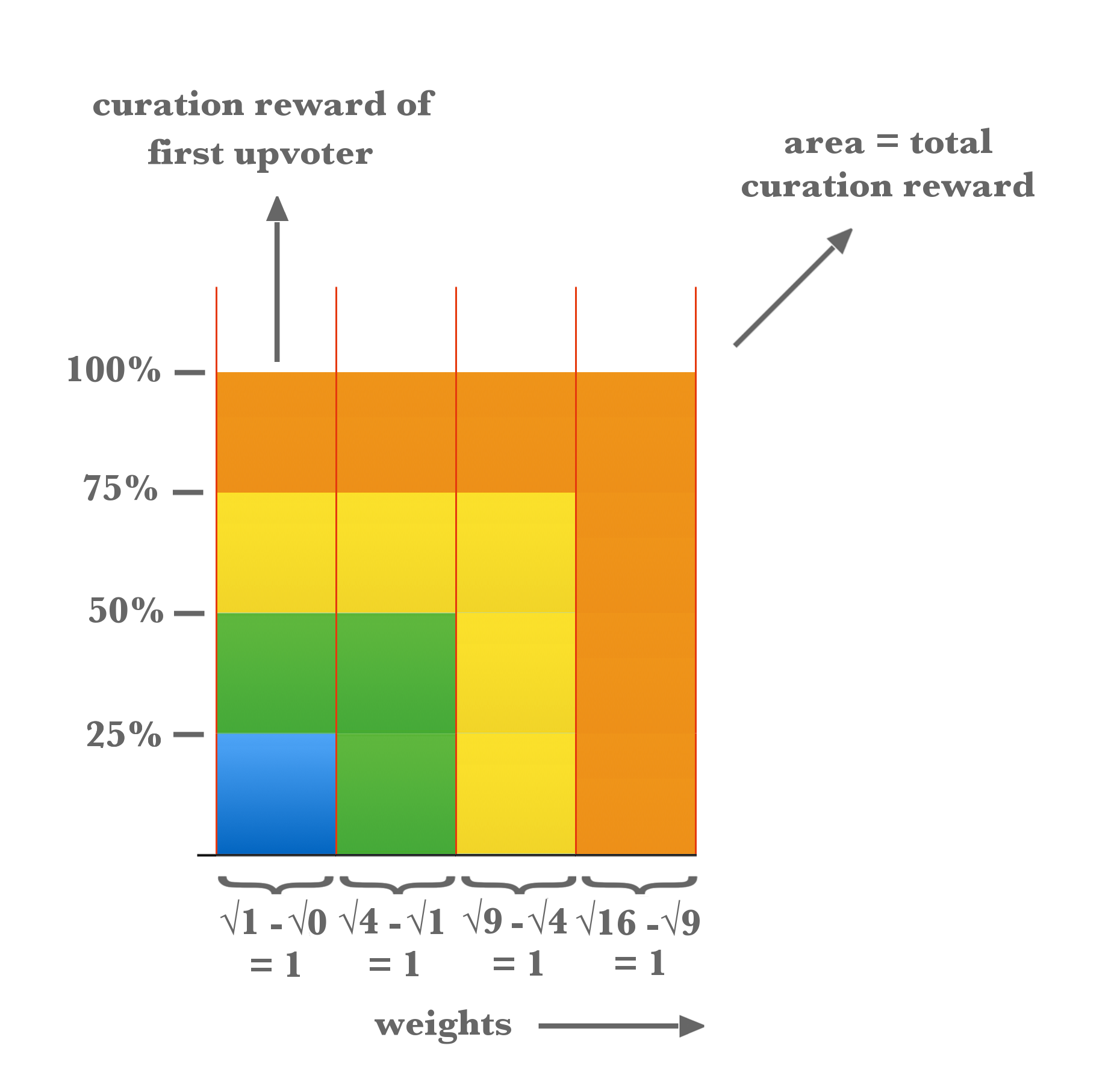
The left hand column (anchored by the blue square) represents the amount of the curation rewards for the curation hound. Each area the size of the blue square is $0.25 worth of curation rewards, generated by $1.00 of upvote. For each successive colour it makes no difference to this example whether one upvoter adds all of the additional post payout or whether it is split between a large number of upvoters.
The milestone increases in curation that we are aiming to derive are as follows:
- Blue: The curation hound adds the first $1.00 to the post payout and at this point would receive all of the curation rewards of $0.25. Their curation weight is √1 - 0 = 1 (the curation weights are based on rshares in practice but here we have scaled them down to the level of the upvotes for simplicity).
- Green: The post payout needs to increase to 4x the original upvote in order for the reward paid to the curation hound to double from 25% of upvote to 50%. At this point the post payout is $4.00, the total curation reward is $1.00, and the weight share for the first upvoter is 1/2 giving a curation reward of $0.50.
- Yellow: The post payout needs to increase to 9x the original upvote in order for the reward paid to the curation hound to treble from 25% of upvote to 75%. At this point the post payout is $9.00, the total curation reward is $2.25, and the weight share for the first upvoter is 1/3 giving a curation reward of $0.75.
- Orange: The post payout needs to increase to 16x the original upvote in order for the reward paid to the curation hound to quadruple from 25% of upvote to 100%. At this point the post payout is $16.00, the total curation reward is $4.00, and the weight share for the first upvoter is 1/4 giving a curation reward of $1.00.
These figures are intuitive once we consider that the curation reward curve is a square root curve such that each linear increase in curation rewards requires the square of that increase in post payout.
We can extrapolate these figures further. Once the post reaches 64x (8 squared) or $64.00 the curation hound payout reward is 200% of upvote, 144x (12 squared) or $144 for 300% of upvote, 256x (16 squared) or $256 for 400% of upvote, and so on.
Early Curators (the blue and green columns in our model)
Now let’s turn our attention to the early curators in our model. Our post payout is 100x the upvote value for each curator so there is potential for a curation reward of over 200% of upvote according to our analysis above. Why do our early curators not receive these stratospheric returns? Why are they not even close?
The answer of course is that our early curators are either (a) returning curation rewards to the author by upvoting within the first thirty minutes (b) paying curation rewards forwards to prior curators or (c) both a and b.
The curation rewards in our model peak at 30 minutes with the 7th upvoter. This curator initially pays forwards almost half (48%) of their curation rewards to the six prior upvoters resulting in an initial ratio of 12.5%. The post payout then increases by 16x from $7.00 to $100.00, giving this curator approximately a fourfold increase in curation rewards from 12.5% to just under 50%. It’s worth noting that in order for this curator to reach a curation reward of 100% of upvote the post payout would have to quadruple to $400 not double to $200.
Our 3rd upvoter only receives curation rewards of 26.5% of upvote. As they upvote at 10 minutes they are returning 66% of curation rewards to the author. They also pay forwards almost half (45%) of their curation rewards to the two prior upvoters. These two impacts taken together reduce their initial curation reward ratio to around 5% of upvote. It’s worth noting that in order for this curator to reach a curation reward of 100% of upvote the post payout would have to be over $1400.
In this latter example there is one fundamental point which may not be intuitive. We pass curation rewards forwards to the author on a linear scale. We recover them from future curators under a square root function. They are thus given away much more easily than they are recovered. If you upvote at 10 minutes you reduce your curation rewards by a factor of three. They post payout would need to increase 9x (not 3x) to recoup these rewards.
Rules of Thumb
Some rules of thumb to help in estimating curation rewards on posts that you are upvoting.
The figures are expressed as “final post payout / post payout after upvote” so 16x would be a $16 post payout if the post value after your upvote is $1.
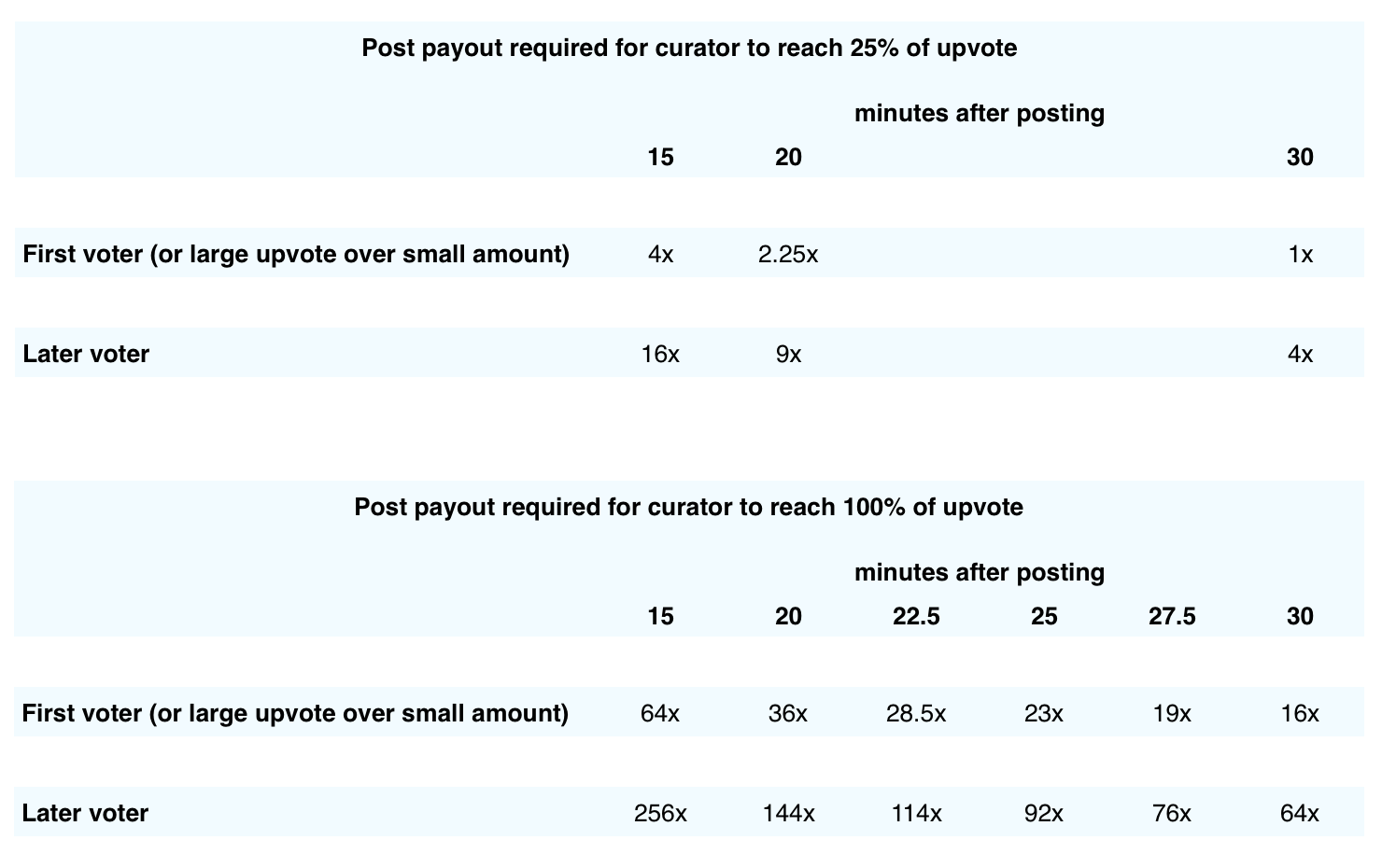
Past Post Example
As in part 1 we finish with a real past post example. This is a completed post from @sndbox. It received total rewards of $289.66 of which curator rewards were $64.17 (22.2%). There were 238 curators (of which two were after the seven day period).
The first chart shows the “curation reward / upvote value" ratio for each curator as the orange line (left hand axis). The upvote values are shown as blue columns (right hand axis). As only the largest upvotes can be seen on this scale we have added the smaller upvotes increased by a factor of 100x (also on the right hand axis) as the blue dots. The x-axis shows the time in minutes of each of the 238 curators by order of upvoting (this axis is not to scale).
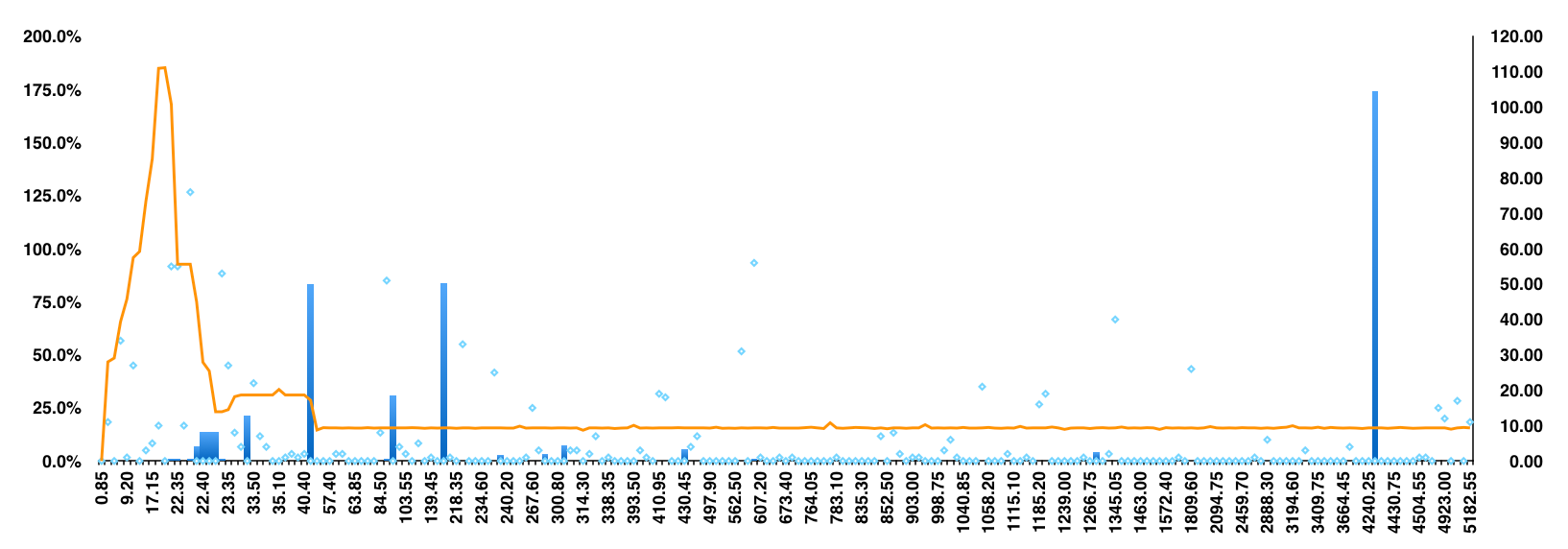
The second chart shows the same information but focused on the first 40 minutes where there were 31 curators. (The blue dots have been removed as the scale is smaller).
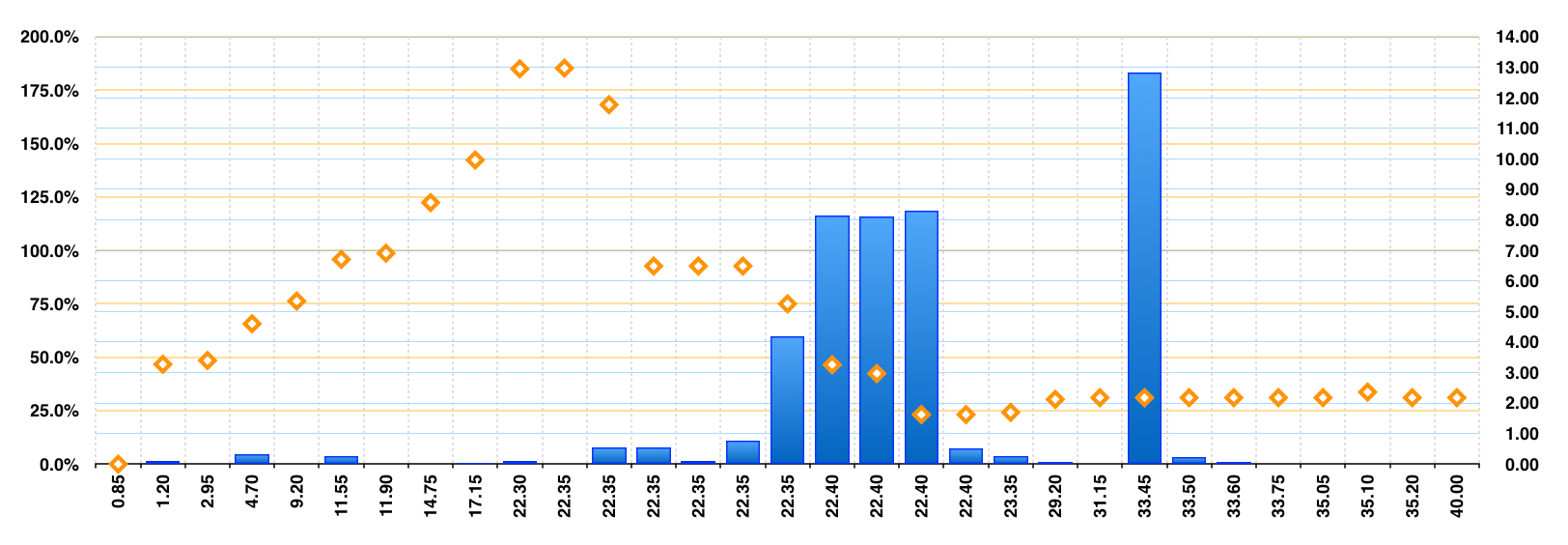
It’s clear that there were some high curation rewards available at early durations on this post. Here are some key points of note in comparison to our model:
The curation rewards ratio increases over the first 22.35 minutes as the proportion of rewards returnable to the author declines. There are $0.91 in total upvotes over this period. Due to the size of the final post payout there were some high curation ratios for small upvotes even as early as 11 minutes.
There is a flurry of upvoting (which we believe to be automated) at 22.35 and 22.40. These curators reap the maximum curation reward ratio, although it is noted that there is a vast difference in ratio between the first of these upvotes (185% ratio) and the last (23% ratio). These curators add $31 of upvotes.
The timing of the maximum curation reward is earlier than in our illustration. Where curators are actively seeking high curation rewards on popular posts there are always likely to be some rewards traded to the author for the benefit of being the first sizeable upvote. We will return to this consideration for other authors in part 3 of our guide.
After this initial flurry the curation reward ratio rises to around 30% (since we are still in the first 30 minutes) before settling back in to the long-tail result for the last 180 curators.
It is interesting to note that the post author @sndbox has delayed their sizeable upvote until after the 40 minute mark. This provides incentive for curators to discover and upvote the post. We will also come back to this consideration in part 3 of our guide.
That’s all for part 2. In part 3 we will take a closer look at the curation battleground of the first thirty minutes for some popular authors. And we will also reveal why you may not be aware of the most valuable curation you undertake.

